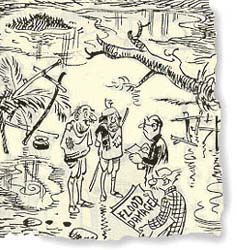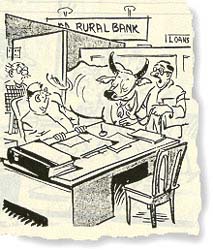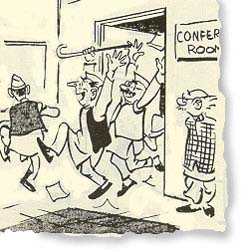 | « Back to article | Print this article |
'No one took umbrage at his depictions, and the subjects least of all, because they knew that Laxman had no malice in him.'
One had to meet him but once and his ever twinkling eyes blew away any negative thoughts one may have nursed about him.'
Dr Shreekant Sambrani remembers the irreplaceable R K Laxman.
On this Republic Day, it is but proper to celebrate the art and person of R K Laxman, the most famous champion of the common man of the Republic.
 The small man of his countless cartoons was a bemused, mute spectator to everyday events as well as upheavals in our ever tumultuous and argumentative Republic (he is believed to have spoken just once in the thousands of cartoons depicting him). Of course, his lady more than made up for his silence with her pithy if garrulous comments on everything under the sun.
The small man of his countless cartoons was a bemused, mute spectator to everyday events as well as upheavals in our ever tumultuous and argumentative Republic (he is believed to have spoken just once in the thousands of cartoons depicting him). Of course, his lady more than made up for his silence with her pithy if garrulous comments on everything under the sun.
I was introduced to Laxman the day I joined The Economic Times in 1978. We took to each other instantly (I suspect my Kannada roots had something to do with it and I am not ashamed to say that I exploited them to the hilt when the occasion demanded!)
Without a doubt, knowing him (and rather well, especially given the short time I was with the newspaper) was one of the greatest perks of my days in the Times of India building. I realised how great that privilege was when I heard columnist Ashok Malik say that in all his years with The Times of India, he got five minutes with Laxman and those too, on the great man's terms.
I saw him every single day of my time with the Old Lady of Bori Bunder. I dropped by his office (next to that of The Economic Times editor) every afternoon to see the next day's pocket cartoon (and the big ones on Tuesdays and Saturdays, which appeared the next day).
I got to see not only the finished drawing but at times earlier sketches as well -- not on many occasions, though, because mostly his first sketch was the final one.
We chatted and exchanged notes on what was happening and once or twice I got the compliment (absolutely undeserved) of having given him an idea. He generously shared the lovely filter coffee from his thermos that came from his house. I also met Kamala, his gracious wife.
 The thing that struck me was that his cartoons, despite their brilliant drawings, were not funny -- mostly -- until you read the caption (in case of You Said It) or the balloon (in case of the larger ones).
The thing that struck me was that his cartoons, despite their brilliant drawings, were not funny -- mostly -- until you read the caption (in case of You Said It) or the balloon (in case of the larger ones).
He captured the irony of the situation largely through the witty comment and the cartoon then became a very eloquent illustration that went with it.
He shared his brother R K Narayan's felicity with words (which he acknowledged times without number). The drawings were full of minute details -- a tilted lamp-post here, a perpetually dug pit there, covered under tattered tarpaulin, and the ever present cop in shorts and the wise beggar.
In this regard, he was similar to his colleague Mario Miranda, whose pocket cartoons of the grumpy boss and his exasperated secretary Ms Fonseca were as much a staple of The Economic Times as Laxman's were of The Times of India.
Laxman was thus different from his idol, Sir David Low, who depended on the drawing to do the talking. That trait was seen more in Abu Abraham (whom also I got to know).
But several of Laxman's most outstanding cartoons needed no words at all. The earliest of this kind I remember was Jawaharlal Nehru becoming a one-man orchestra, playing several Indian instruments at once, a telling comment on his simultaneously assuming many positions in the government and the party.
His most telling commentary was on Indira Gandhi sweeping the polls in 1971. It showed her wielding the broom (four decades before it became fashionable) and the Syndicate leaders being reduced to tiny doll-like figures swept into a trash can.
He was to repeat that in 1980 with a fresh set of leaders swept away, and a triumphant Mrs Gandhi beaming at a job particularly well done with one hand on her hip.
Laxman's cartoons were caricatures, but not lampoons. They captured the most outstanding feature of the subjects without making fun of them.
Nehru always had a benign smile. He was without his cap, with tufts of hair surrounding his bald pate.
Indira Gandhi's prominent nose became sharper and more pointed as time progressed. She had always an unruly tress on her forehead.
Rajiv Gandhi's drawings were ever reminiscent of an overgrown schoolboy with pudgy cheeks which became pudgier and the hairline thinner. Morarji Desai's glasses dominated his bony face. His kurta-jacket-cap clad figure with a stern visage was always small in size.
 No one took umbrage at these depictions, and the subjects the least of all, because they knew that Laxman had no malice in him.
No one took umbrage at these depictions, and the subjects the least of all, because they knew that Laxman had no malice in him.
One had to meet him but once and his ever twinkling eyes blew away any negative thoughts one may have nursed about him. That attribute of his cartoons is especially relevant these days when every leader worth the salt takes affront at the drop of a line. I am sure Laxman would have found our sartorially hep prime minister a delight to draw.
Laxman told me that I often pointed out some incongruity or the other. He encouraged me to continue doing so. He said that just because I worked in The Economic Times did not mean that I should lose a sense of humour and perspective, especially since my day job brought me face to face with the ridiculous every day.
He even suggested that I write middles, just as he had encouraged the head of advertising Dronachalam (he wrote under the nom de plume D'chalam about some fictitious detective). I followed his advice many years later.
Laxman maintained that he was an artist first and last and a cartoonist by accident to earn his livelihood (what a livelihood it was, being the highest paid Times of India employee even then and all through his years thereafter!)
He said his best drawings were of his beloved crows. He even published a book of them. He once said (I think purely as a throwaway aside) that he would make a sketch of me. To my everlasting regret, I did not take it seriously.
Long before marketing wizard and social commentator Rama Bijapurkar and her generation discovered the phrase, 'We are like that only' to describe our many collective follies and contradictions, Laxman was pointing them out with gentle humour through his marvellous pencil.
Many people have recently said Je suis Charlie, but how many could justifiably say Naanu Laxman iddene (I am Laxman)?
Dr Shreekant Sambrani was the first Chief of Research Bureau of The Economic Times.